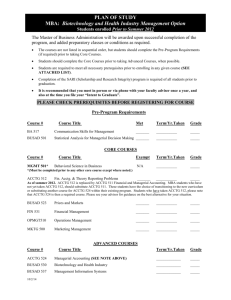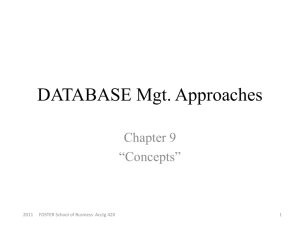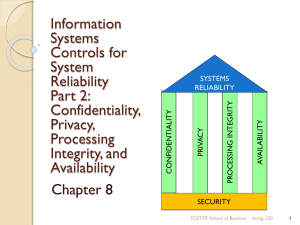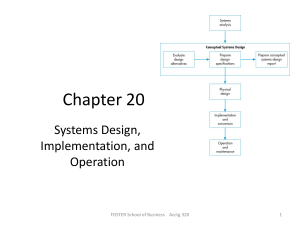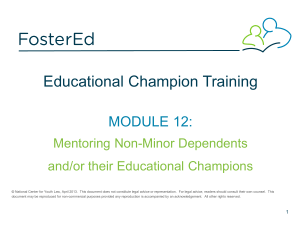Database Administration
advertisement
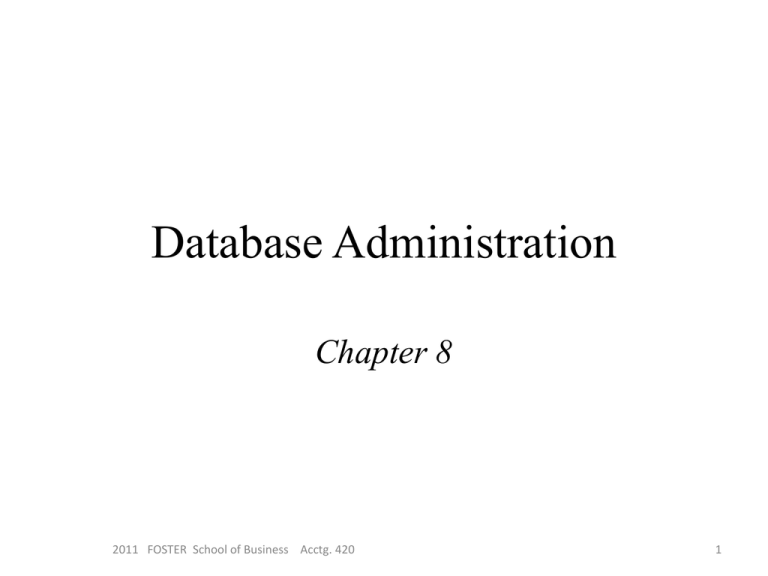
Database Administration Chapter 8 2011 FOSTER School of Business Acctg. 420 1 Database Administration Database administration (DBA) is an organization group responsible for supervising both the database and use of DBMS. DBA: * formulates DB policies, * communicates policies to users, and * enforces these policies. 2011 FOSTER School of Business Acctg. 420 2 Database Administration The DBA must be able to communicate with all levels of users. They need to protect the integrity and the security of the database. Universities are required to have disaster planning policies in place as part of the IT strategic plan. 2011 FOSTER School of Business Acctg. 420 3 Policies Access Privileges—who needs access to what, why? Security—encryption, views, authentication, authorizations. Disaster Planning—duplicate back-up system, recovery: forward (use back-up copy & log after image), backward (use log before image). UPS Archiving—how long should we keep our data (live versus archive)? Move from live to archive storage. live (online) archive (offline) disposal or mass storage in data warehouse. 2011 FOSTER School of Business Acctg. 420 4 Archiving (continued) Data retention is affected by legal requirements (complicated and expensive): SOX (2002) – financial records Patriot Act (2001) – customers and accounts at financial institutions. SEC rule 17a-4 – electronic communications. DoD 5015.2 Standard (1997) – data mgt. req.s HIPAA (1996) – health-care transactions. 2011 FOSTER School of Business Acctg. 420 5 Other DBA Functions DBMS Evaluation & Selection DBMS Maintenance: responsible for changer & updates. Data Dictionary Mgmt. Training DB Design Testing Performance Tuning: change DB design to improve performance. 2011 FOSTER School of Business Acctg. 420 6 DBMS Evaluation & Selection (see Fig. 8-8 in text) When a new system is purchased, the DBA must evaluate each prospective purchase against a list of requirements (e.g., Fig. 8-8). The checklist will include specifics re: data definition, data restructuring, nonprocedural languages, data dictionary, concurrent update, backup & recovery, security, integrity, replication & distributed DBs, limitations, documentation & training, vendor support, performance, portability, cost, and special requirements. 2011 FOSTER School of Business Acctg. 420 7 DBMS Maintenance DBA: decides on updates, coordinates people when problems occur, decides and coordinates user’s special requests. 2011 FOSTER School of Business Acctg. 420 8 Data Dictionary Mgmt Depending on the DBMS, DBA creates data definitions, updates contents, creates & distributes reports. ----------------------------------------------------------- Training DBA responsible for training. Expensive but essential. 2011 FOSTER School of Business Acctg. 420 9 DB Design DBA does the physical-level design of the DB. Controls documentation standards for all steps. Controls all changes. 2011 FOSTER School of Business Acctg. 420 10 Testing Production (live) system: hardware, software, and database for users. Test (sandbox) system: where programmers create a separate (new) system. After the new system is developed, tested and approved, it is transferred to production system. 2011 FOSTER School of Business Acctg. 420 11 Performance Tuning Performance = ability of the system to serve users in a timely and responsive way. DBA must get the best performance from available funds. Improve performance by buying faster: network, software, disks, & hardware. When funds are constrained, then DBA will change DB design to improve performance – this is called tuning the DB design. 2011 FOSTER School of Business Acctg. 420 12 Tuning A few of the DB changes that a DBA can make to tune the system include: * Modifying indexes—create and delete. Can speed up searching and joining tables. Tables with many indexes take longer to update. * Splitting tables—could increase overall performance. -sometimes done for security (could use views) * Changing table designs—cost/benefit to denormalize tables. Sometimes users change their data needs and the DB may have to be changed to efficiently address the current need. 3NF 2NF or 1NF (This can increase performance for certain types of transactions, depends on users needs.) 2011 FOSTER School of Business Acctg. 420 13 Quick Quiz 1) A(n) _____ specifies the ongoing and emergency actions and procedures required to ensure data availability, even if a disaster occurs. 2) _____ is the prevention of unauthorized access, either intentional or accidental, to a database. 3) In ordinary usage, a(n) _____ is a place where public records and documents are kept. 2011 FOSTER School of Business Acctg. 420 14

